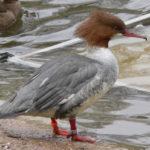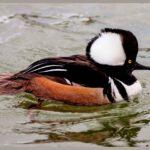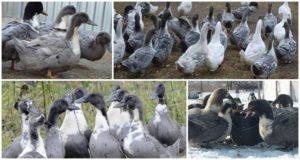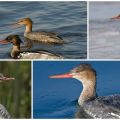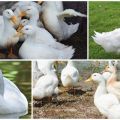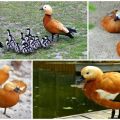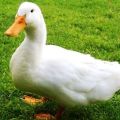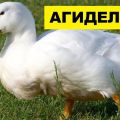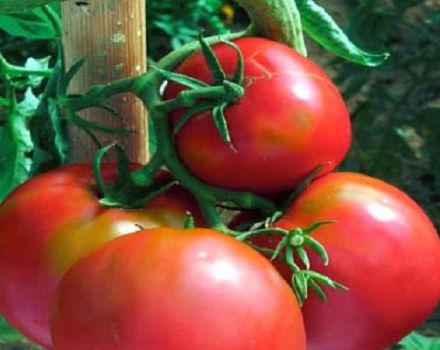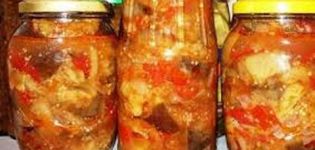Description of the species and characteristics of merganser ducks, what they eat and lifestyle
The merganser duck is a taiga inhabitant. A waterfowl is called a toothed bird. The merganser's beak is adapted for fishing in habitats - fresh and salted lakes and rivers. Mergansers are divided into three types: large, medium and small. The population of the most widespread, large merganser, is stable. But other species of birds are rare birds and are under protection.
Origin of the species and description
The Krokhal genus belongs to the Duck family of the Anseriformes detachment. External characteristics of a large merganser:
- body length - 66 centimeters;
- average weight - 1 kilogram;
- wingspan - 97 centimeters;
- the serrated beak is pointed and bent down at the end.
On the outside of the unfolded wings of birds, there is an extensive white mark, or "mirror".
For mergansers, sexual and age-related demorphism is characteristic:
- male (drake) - the body is black-gray-white, the head and neck are black, with a dark green shiny tint, a red beak. In the fall, the green tint disappears. The beak and eye on both sides of the heads are separated by a light stripe;
- female (duck) - gray-white, with an auburn head and neck. There is no strip of light feathers on the head;
- the young are gray-brown, with a dark head and a white throat.
The average, or long-nosed, merganser is smaller than a large relative. The bird's body does not exceed fifty centimeters in length. The wingspan is 67-86 centimeters. The nape of the males during the mating season is decorated with a double tuft. The plumage is distinguished by a red-white color on the chest, as well as a brown goiter and red paws.
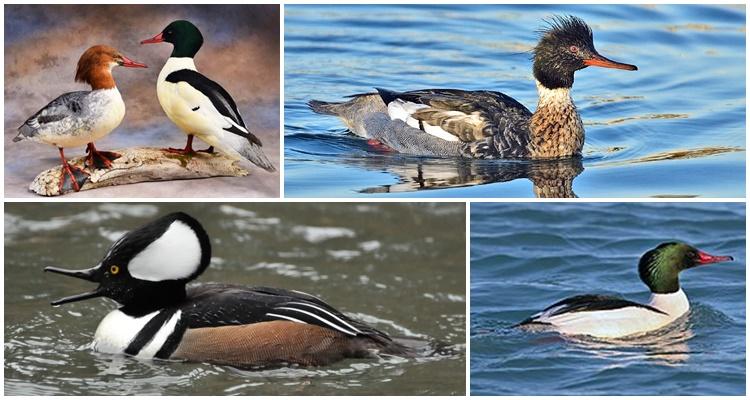
The small merganser reaches forty-four centimeters in length and weighs 680-935 grams. Black and white males are larger than variegated females. According to its external features, the bird approaches both gogol and merganser at the same time, but it is allocated as a separate genus Lutkov. Scaly, Brazilian and crested merganser are also distinguished, which are less common than other species.
The great merganser is divided into several subspecies, which are distinguished from each other and from other varieties by the wavy gray pattern on the wings and the territory of distribution.
Habitat of the merganser duck
Toothed ducks belong to migratory and partially migratory birds. They live in northern latitudes, and for the winter they migrate to the subtropics, to the sea coasts, and also settle near water bodies in a temperate climate.
| Kinds | Subspecies | Area | Wintering |
| Big | North of Denmark and Scandinavia, Alps, Great Britain, Iceland, Poland, Belarus. Kola Peninsula, Yamal, the Yenisei, Vilyui, Lena, Kolyma ridge, northern Chukotka, western Siberia, southern Alaska, Quebec, Newfoundland | Baltic, North, Black, Caspian Sea, Central, South Europe, Central Asia, Japan, Korea, China | |
| Holarctic | Forest-tundra and taiga of the western and eastern hemisphere | ||
| Nominative | Iceland, northeastern China, northern Japan | ||
| Central Asian
| Territories from northeastern Afghanistan to western China, Tibet, Himalayas. | ||
| Middle | North America, Eurasia, northern regions, tundra, forest-steppe belt | Moves to the sea in a subtropical and temperate climate | |
| Small | The northern border of the area covers taiga, forest-tundra of Scandinavia, Kamchatka, the coast of the Sea of Okhotsk, Sakhalin, the Shantar and Hokkaido islands, northern Sweden and Norway, the Yenisei, Indigirka, and Kolyma rivers. The southern border passes through Finland, the upper reaches of the Lena and Sakmara rivers. Found in Romania, in the Urals, on the Black Irtysh River | Moderate, southern latitudes, boundaries of ice fields. Wadden, Baltic, Black, Caspian Sea, Pakistan, south of France, England, sometimes reservoirs of central Europe. North Africa: center of Iraq, Tunisia, Algeria, Egypt. | |
| Scaly | Primorsky Territory, the south of the Khabarovsk Territory along the Sikhote-Alin mountain range, Changbai Mountains on the border of China and Korea and in the mountains of the Little Khingan | South Korea and China |
The number of migrating mergansers changes every year. In mild winters, part of the population remains on the nesting grounds. Other flocks move short distances and do not reach southern areas. In addition to sea coasts, birds winter on lakes with fast currents, in lagoons and widening estuaries of rivers flowing into the sea.
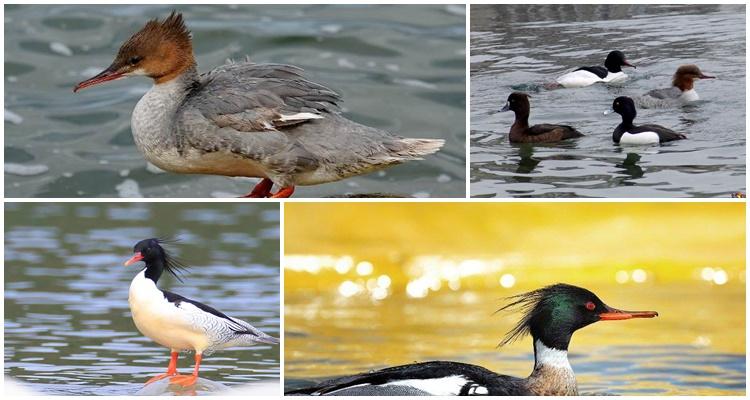
Mergansers fly away in late autumn or early winter, when the water freezes, and return in early spring, during the first thaw.
What does the bird eat
Merganser diet:
- a fish;
- crustaceans;
- aquatic insects;
- worms.
The scaled merganser is a carnivorous bird. Smell feeds on fish only in winter and early spring, the rest of the time does not neglect plants. Ducks eat trout, salmon, eel, grayling, roach, barbus and pike. They also feed on herring and sea fish. The type of food is determined by the nesting or wintering place.
To catch a fish, the mergansers lower their heads under the water and mark the target. The birds fully dive, grab the fish with their beak and emerge. They swim underwater with their paws. Thanks to the teeth, the fish does not slip out of the beak. During flights, the mergansers arrange general fishing, similar to synchronized swimming. Birds flock across the lake and then dive at the same time.
Character and lifestyle
Merganser ducks swim well, dive and fly. Birds live in solitude, spend the whole day on the water and do not come into contact with other birds. They aggressively protect their offspring. Migratory mergansers live up to ten years. Birds leading a partially migratory lifestyle live up to fifteen years, and sedentary ones - up to seventeen. Ducks nesting sites:
- lakes with clear water surface from vegetation;
- reservoirs;
- upper fast streams of rivers.
Birds usually inhabit the shaded banks of large bodies of water. For takeoff, they need a lot of acceleration on the water. The big merganser chooses piedmont reservoirs and hills. Scaly mergansers nest in the hollows of coastal trees. Small slugs take off more easily from the water, so they prefer to settle on reservoirs with coastal vegetation.

Social structure and reproduction
The age of sexual maturity of the merganser is 2 years. Birds return from wintering, forming pairs. Male behavior during mating season:
- the wings are lowered to the water;
- the tail is directed up;
- sharply tilts and raises his head;
- flaps its wings, rises above the water;
- flies up, presses the red beak to his chest.
Talking males call females with their voice.A long-nosed drake croaks lingeringly, and a duck responds with a short "gro" sound. Male swoop rarely makes a crackling sound resembling croaking. The female of the little merganser during the mating season and during the rearing of chicks is recognized by a hoarse croaking and a monosyllabic call.
Several pairs of birds coexist in one section of a river or lake. Finding a place for a nest and raising chicks are the duties of females.
Birds settle at a distance of a kilometer from the water and nest in the following places:
- natural holes in tree trunks and stumps;
- woodpecker hollows in coastal willows, aspens, elms and alders;
- cracks in rocks;
- crevices between large stones;
- abandoned buildings;
- rarely in the grass, at the roots of shrubs.
Ducks lay their eggs on wood dust or cover the bottom of the nest with down and feathers. As soon as the female lays eggs, the male leaves her. It rarely stays until chicks appear. Drakes live alone and rarely moult in groups. Merganser eggs are white or yellow-cream, without dots and patterns. Average number in clutch - 11. Duration of incubation - 30 days. Ducks get their own food. Before leaving for feeding, birds cover eggs with fluff.
Females raise their own chicks and fosterlings if neighbors die from attack by predators or leave the clutches. One duck can raise 75 chicks.
The hatched ducklings are covered with two-colored down - dark on the back and light on the belly. For the first time they jump out of the nest on the second day after birth, follow their mother to the water and learn to get food - insects that live on the surface of the reservoir. The mother duck rolls the ducklings on its back. At ten days of age, the cubs taste animal food - fry. Gradually, the chicks become independent. Hardy ducklings escape from predators by moving quickly through the water. Cubs distract enemies by pretending to be dead to give the mother duck time to escape. At two months they begin to fly.
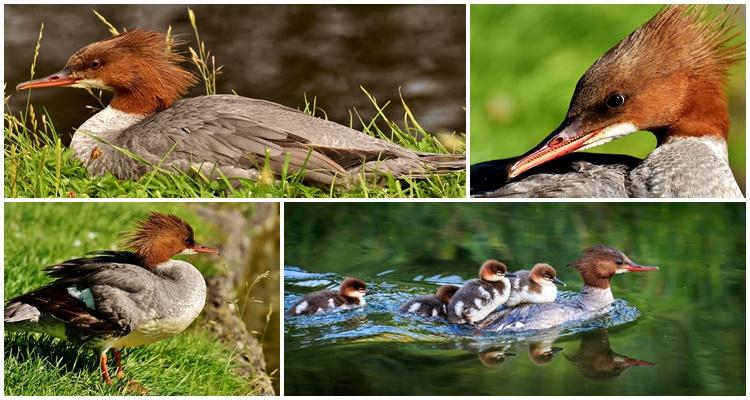
Natural enemies
Merganser Predators:
- Fox;
- raccoon dog;
- otter;
- mink;
- marten.
Terrestrial forest dwellers attack adult ducks, find their nests and eat their eggs. A hawk, an owl, an eagle are dangerous from the air. Snakes also hunt chicks and eggs.
Population and status of the species
In 2014, the total number of the rare scaled merganser was 5000 individuals. 85 percent of the world's population lives in Russia. The population of long-nosed and large mergansers is out of danger. At present, the Auckland variety of the toothy duck that lived in New Zealand has been lost. Cats and pigs are to blame for the extermination of birds. The fate of the New Zealand relatives may befall the Brazilian population.
Protection of merganser ducks
The reasons for the decrease in the number of birds:
- clearing old forests along the banks of valley rivers;
- shooting;
- fishing with nets;
- dam construction;
- water pollution.
The protection of the big toothy duck is regulated by the European environmental conventions and the red books. In Russia, hunting for a scaled merganser is prohibited, but hunting for loot is allowed. To preserve species diversity, annual monitoring of the number of ducks and factors affecting their vital activity and migration is carried out. The birds are protected in nature reserves.





